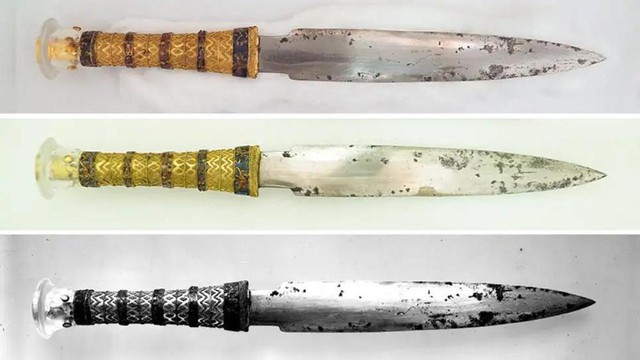The value of this is far beyond gold and silver jewels
Few Egyptians, both ancient and modern, are as famous as King Tut – also known as Pharaoh Tutankhamun – the last of his royal line to rule at the end of the 18th Dynasty.
Today, the emperor’s popularity comes from the fact that his tomb was discovered in 1922 quite intact, filled with precious treasures. One of the burial artifacts that attracts a lot of attention is an iron dagger. Because in King Tut’s time, the technique of smelting and making iron was very low, so this artifact was valued by experts as having a higher value than gold.
Today, the dagger is valuable for another reason: The high nickel content in the blade is because it came from meteorites. Recently, its value has increased when a new study revealed that neither nickel nor daggers originated in Egypt.

Two pictures above: two sides of a dagger. Below: 1925 photo of the knife. Photo: T. Matsui et al./Meteorit. Planet. Sci.

Mask of Tutankhamun – the famous king of ancient Egypt. Photo: wikipedia
According to research published in the journal Meteoretics and Planetary Science, the scientists said: “This iron object of good quality shows that at the time, metallurgical techniques were possible. with very good meteorite-derived materials. However, how the knife is made is still a mystery.”
Also according to the study, the exquisite quality of Tut daggers was very special for that era. King Tutankhamen reigned from 1332 to 1323 BC during the late Bronze Age and pre-Iron Age.
Given the age and quality of this knife along with several other daggers of that era, iron must have been a special metal, and the only source of iron thought to have existed at that time came from a meteorite .
Octagonal meteorites are the most common structural class of iron meteorites. This structure occurs because iron meteorites have a nickel, which leads to the decomposition of kamacite from taenite as it cools.
The study’s co-author, researcher Tomoko Arai at Chiba Institute of Technology, Japan, shared that his team had to use non-contact two-dimensional chemical analysis because the blade was heavily rusted.
The concentration of iron, nickel, manganese, cobalt sulfur, chlorine, calcium and zinc in the knife after analysis helped determine the origin of the knife as an octahedral meteorite.

Widmanstätten structure on an octahedral meteorite from Namibia.Photo: kevin zim / Kevin Walsh
The good news is that researchers have identified the type of meteorite, the bad news is that the octahedron belongs to the most common group of iron meteorites, which can be found everywhere. For example, the Shirahagi meteorite discovered in April 1890 in Japan’s Kamiichi-gawa River was used to make a Japanese sword that Emperor Taishō bought in the early 1900s.
All the team was able to determine was that the dagger was forged at a relatively low temperature, because high heat would destroy the Widmanstätten structure. King Tut may not have needed the dagger as a weapon, but like all kings of power and wealth, he craved more, and the unique dagger was an example.
at Blogtuan.info – Source: cafebiz.vn – Read the original article here



